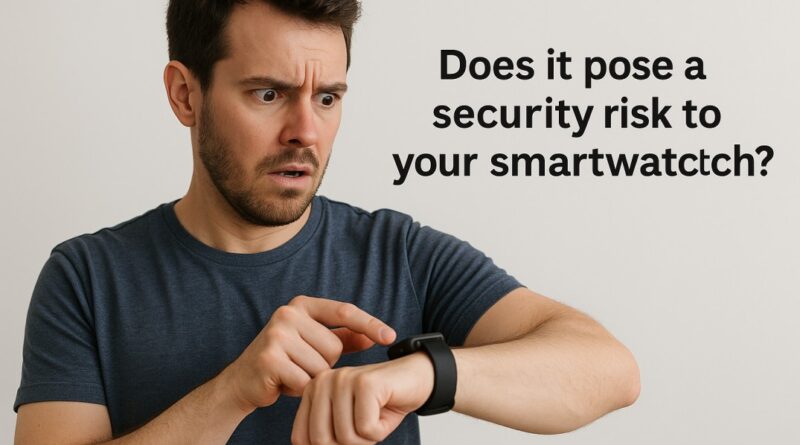Does It Pose a Security Risk to Tap Your Smartwatch?
Smartwatches have transformed from futuristic gadgets into essential daily companions. These wearable devices sync with our smartphones, track our health metrics, and even handle financial transactions with a simple tap. But as millions of Americans embrace this convenient technology, a critical question emerges: does it pose a security risk to tap your smartwatch?
Modern smartwatches like the Samsung smartwatch and Apple Watch offer impressive security features, including encrypted communications and secure payment processing. However, their constant connectivity and data collection capabilities also create potential vulnerabilities that cybercriminals can exploit. Understanding these risks is crucial for making informed decisions about your digital security.
The convenience of tapping your wrist to pay for coffee or unlock your car comes with trade-offs. While manufacturers implement robust security measures, no technology is completely immune to threats. This article examines the real security implications of smartwatch usage and provides practical guidance for protecting yourself.
Common Security Risks Associated with Smartwatches
Data Interception During Syncing
Does it pose a security risk to tap your smartwatch when it syncs with your phone? The answer depends on several factors. Smartwatches constantly exchange data with paired smartphones through Bluetooth connections. During this process, sensitive information including health data, location history, and personal messages can be vulnerable to interception.
Cybersecurity researchers have demonstrated that unencrypted Bluetooth connections can be compromised through man-in-the-middle attacks. When your smartwatch syncs in public spaces with many connected devices, hackers may attempt to intercept the data stream. This risk is particularly relevant for older or best cheap smartwatch models that may lack advanced encryption protocols.
The scope of intercepted data can be extensive. Modern smartwatches collect heart rate patterns, sleep cycles, GPS coordinates, and even voice recordings from virtual assistant interactions. If this information falls into the wrong hands, it could be used for identity theft, insurance fraud, or targeted phishing attacks.
Vulnerabilities in Third-Party Apps
Does it pose a security risk to tap your smartwatch when using third-party applications? Many security breaches stem from poorly designed apps rather than the hardware itself. The appeal of finding the best affordable smartwatch sometimes leads users to devices with limited app vetting processes.
Third-party fitness apps, social media platforms, and productivity tools installed on smartwatches often request extensive permissions. These apps may access your location, contacts, and even camera functions on connected devices. Malicious apps can exploit these permissions to steal personal data or install malware on your smartphone.
Even legitimate apps pose risks if they contain security flaws. Developers may not implement proper encryption for data transmission or storage, leaving user information vulnerable to hackers. The rapid development cycle of smartwatch apps sometimes prioritizes features over security, creating potential entry points for cybercriminals.
Bluetooth and Wireless Connectivity Threats
Does it pose a security risk to tap your smartwatch to pay for a purchase at a store? Payment-related risks represent some of the most serious security concerns. While contactless payments through smartwatches use tokenization and encryption, the wireless communication itself creates attack surfaces.
Bluetooth Low Energy (BLE) protocols used by most smartwatches have known vulnerabilities. Hackers can potentially eavesdrop on communications, inject malicious commands, or even take control of connected devices. Public spaces with high device density increase these risks significantly.
Wi-Fi connectivity on advanced smartwatches introduces additional vulnerabilities. When your device automatically connects to public networks, it may expose your data to network-based attacks. Cybercriminals often set up fake hotspots specifically to capture information from connected devices.
Safeguards and Prevention Strategies
Strong Authentication and Access Controls
Implementing robust security measures significantly reduces the question of whether does it pose a security risk to tap your smartwatch. Start with strong, unique passwords for your smartwatch account and associated services. Many users underestimate the importance of securing their wearable devices with the same diligence they apply to smartphones or computers.
Enable two-factor authentication (2FA) wherever possible, particularly for payment apps and health tracking services. This additional security layer ensures that even if your password is compromised, unauthorized access remains difficult. Modern Samsung smartwatch devices and other premium models offer biometric authentication options like fingerprint scanning for added security.
Configure your smartwatch to automatically lock after periods of inactivity. This prevents unauthorized access if your device is lost or stolen. Some of the best smartwatch models include features like automatic unlocking when connected to trusted devices or locations, balancing security with convenience.
Regular Software Updates and Maintenance
Does it pose a security risk to tap your smartwatch cyber awareness 2025? Staying current with software updates is crucial for maintaining security. Manufacturers regularly release patches that address newly discovered vulnerabilities and enhance existing security features.
Enable automatic updates whenever possible to ensure your device receives critical security patches promptly. This is particularly important for budget-conscious users who choose the best cheap smartwatch options, as these devices may have less frequent update schedules.
Regularly review and audit the apps installed on your smartwatch. Remove applications you no longer use, as they continue to represent potential security vulnerabilities. Check app permissions periodically and revoke access for any functions that seem unnecessary or excessive.
Careful App Selection and Management
The security of your smartwatch largely depends on the quality of installed applications. Research apps thoroughly before installation, focusing on developer reputation, user reviews, and privacy policies. Stick to official app stores when possible, as they typically implement better security screening processes.
For those seeking the best affordable smartwatch experience, prioritize devices that support well-established app ecosystems with strong security oversight. While cheaper alternatives may offer similar features, they often lack the rigorous security standards of major platforms.
Monitor your smartwatch’s data usage and battery consumption regularly. Unusual patterns may indicate malicious app activity or unauthorized data transmission. Many users discover security issues by noticing unexpected changes in device performance or data consumption.
Expert Opinions on Smartwatch Security
Cybersecurity professionals generally agree that does it pose a security risk to tap your smartwatch to pay for a purchase at a store cyber awareness initiatives should include wearable device education. According to recent industry reports, the security risks associated with smartwatches are manageable but require active user engagement.
Security researchers emphasize that the best smartwatch for security isn’t necessarily the most expensive model. Instead, they recommend focusing on devices with strong manufacturer support, regular security updates, and robust encryption standards. This approach often makes mid-range options more secure than premium devices from lesser-known manufacturers.
Industry experts consistently highlight the importance of user behavior in smartwatch security. The most secure device can be compromised by poor password practices, neglected software updates, or careless app installation habits. Education and awareness remain the most effective tools for preventing security breaches.
Pros and Cons of Smartwatch Usage
Pros
- Convenience: Quick access to notifications, calls, and apps without reaching for your phone
- Health Monitoring: Comprehensive tracking of fitness metrics, heart rate, and sleep patterns
- Contactless Payments: Secure, tokenized transactions for purchases
- Emergency Features: GPS tracking and emergency calling capabilities
- Productivity: Calendar reminders, message responses, and voice commands
Cons
- Privacy Concerns: Extensive data collection including location, health, and behavioral patterns
- Battery Dependency: Regular charging requirements and potential data loss during battery failures
- Limited Screen Size: Restricted functionality compared to smartphones
- Cost Considerations: Initial purchase price plus ongoing subscription costs for cellular models
- Security Vulnerabilities: Potential exposure to data breaches and unauthorized access
For more information about Best Smartwatch, visit our site Tech Verse and explore expert insights and solutions.
Frequently Asked Questions
Does it pose a security risk to tap your smartwatch in USA specifically?
The security risks of using smartwatches are consistent globally, including in the USA. However, American users benefit from stronger consumer protection laws and regulatory oversight. The risk level depends more on individual security practices than geographic location.
Are expensive smartwatches more secure than budget models?
Premium smartwatches typically offer better security features, including more frequent updates, stronger encryption, and better app vetting processes. However, proper security practices matter more than price point for overall protection.
Can hackers access my smartphone through my smartwatch?
Yes, if both devices are compromised. A infected smartwatch can potentially serve as a gateway to your smartphone, especially if they share accounts or have extensive synchronization enabled.
Should I disable certain features to improve security?
Consider disabling features you don't actively use, such as Wi-Fi auto-connect, location services for non-essential apps, and microphone access for voice assistants when privacy is a priority.
How often should I review my smartwatch security settings?
Conduct a comprehensive security review monthly, including checking app permissions, updating passwords, and reviewing connected accounts. This regular maintenance significantly reduces security risks.
Making Smart Choices About Smartwatch Security
The question of whether does it pose a security risk to tap your smartwatch doesn’t have a simple yes or no answer. Like any connected device, smartwatches present both benefits and risks that users must carefully balance.
The key lies in making informed decisions based on your personal security needs and risk tolerance. Choose reputable manufacturers, maintain strong security practices, and stay informed about emerging threats. With proper precautions, the convenience and functionality of modern smartwatches can be enjoyed while minimizing security exposure.
Remember that perfect security doesn’t exist in any technology. The goal is managing risks to acceptable levels while maximizing the benefits these innovative devices provide. By following the guidelines outlined in this article, you can confidently embrace smartwatch technology while protecting your digital security.

